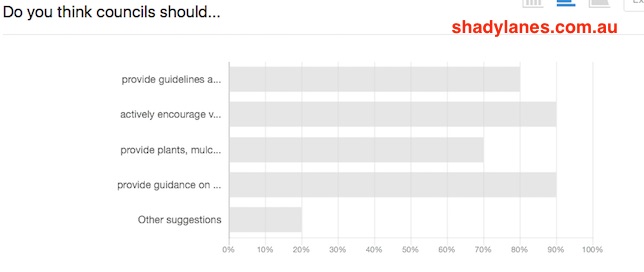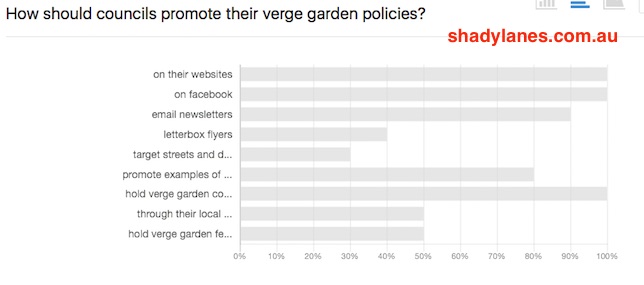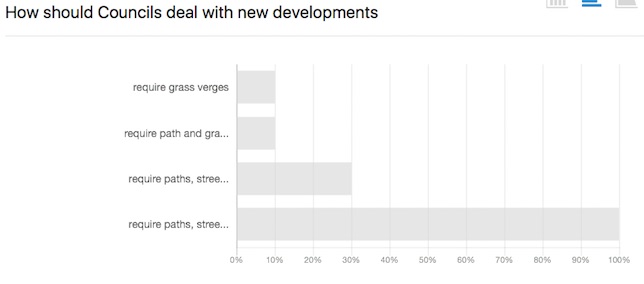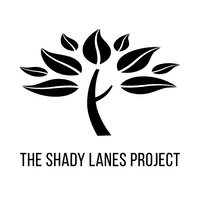In our second survey, in February 2020, we looked at our expectations of councils. Many thanks to all who participated. This is what we found.
Council Policies
Council policies vary widely. Some are basic guidelines, others require formal applications, landscape plans, and payment for permits for the most basic verge garden. Readers could select as many as they wished.

Most popular opinion was that councils should actively promote verge gardens and provide guidance on which plants to use.
Most thought councils should provide guidelines and, as long as residents stay within the guidelines, they can plant as they choose. As none wanted permits, we can only assume these people didn’t want any restrictions or guidelines.
More than half thought that councils should provide plants, mulch or other assistance.
Nobody selected
-
- require written applications and issue permits for verge gardens
- require detailed plans of the proposed garden
- have a fee for applications or permits
Readers comments include:
“Councils should install ‘rain gardens’ where-ever possible”
“You get a ‘verge permit’ by reading & answering a series of online questions.”
Promotion of verge gardens and policies
Even though Brisbane has had a policy for three years and it is on their website, I regularly come across people who are sure that the council forbids verge gardens. Word isn’t getting out there.
 All respondants thought councils should promote their policies on their website and facebook – and hold verge garden competitions. Kudos to Subiaco (WA), Bayswater (WA), City of Charles Sturt (SA) on including verges in their garden competitions.
All respondants thought councils should promote their policies on their website and facebook – and hold verge garden competitions. Kudos to Subiaco (WA), Bayswater (WA), City of Charles Sturt (SA) on including verges in their garden competitions.
Most wanted to see it in council email newsletters, and the want to see examples of verge gardens.
Activities like festivals, through councillors and doorknocking were either less popular or thought to be less effective.
Readers comments include:
“I’d like to see local groups such as bush care and community gardens or other community groups able to coordinate verge gardening activities.”
“Via the Gardens For Wildlife program for the Victorian Councils who host. Through schools, community gardens & their own indigenous nursery. Create an anonymous listing of verge gardens — see Habitat Stepping Stones site & their map.”
New Developments

New residential developments are an area where councils can influence what is seen as the ideal or normal treatment of verges and nature strips. All participants thought paths, street trees and gardens should be required.
Readers comments include:
(Development raised lots of comments – only those specific to verge gardens are included here.)
“The street trees and gardens should be indigenous to the local area. For those in fire-prone areas, these indigenous plants should also be fire-resistant”
“Encourage developers to see street gardens as a promotional opportunity”
“…verges could be more rain garden design, capturing & filtering water.”
Additional Comments
“Councils should also require industrial areas/ shopping centres etc plant gardens and verges with indigenous plants.”
“Really important that verges don’t become vestiges for weedy species. Thought needs to be given to transfer of verges… one enthusiastic person might create a verge garden, sell house & next person may have no interest, meaning all that all the hard work is gone if they decide to remove & regrass for ease.”
What Have We Learned
In compiling our directory of council policies, we’ve found guidelines vary from basic safety to severe restrictions which could explain different attitudes to guidelines.
While a few councils are enthusiastic in their promotion of verge gardens and their policies, many have them well hidden on their websites.
Very few councils provide assistance converting grass to gardens, although almost all provide the street trees. It is debatable how much more councils should do. Part of the framework of the Shady Lanes Project is that alternative methods are used to fund the transformation of verges, especially in disadvantaged suburbs.
The suggestion of simple online checklists for a permit is something councils might want to consider – it could become part of their systems for measuring and increasing their urban canopy.
What’s Next?
We will use the results of this survey to guide the development of Shady Lanes Project, and encourage you to use it as well.
Our March Survey is about walkability and we explore how verge gardens affect pedestrians. Check it out here.
Feedback, including suggestions and requests for questions on our monthly surveys, is welcome.
